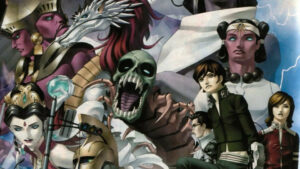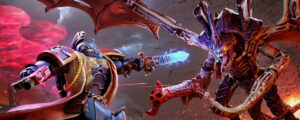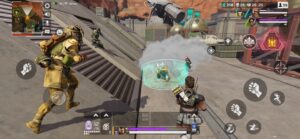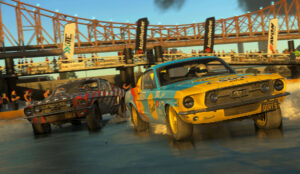From the Old World to the New World, the first two Total War Warhammer games almost felt like they were avoiding talking about Chaos. Sure, it was there, its roving armies sometimes marching down from the North, its influence still felt through aligned factions, but it was always kept a little out of focus. For Total War Warhammer 3, Chaos is revealed in all its multi-faceted glory, arrayed against the two Eastern empires that work tirelessly to keep it at bay.
After the first two Total War Warhammer games arrived in quick succession, Creative Assembly took more time to deliver the third game in the trilogy, cooking up new and more interesting additions to their expansive style of grand strategy campaigning, a new central hook for the overarching story and how it ties in with the core gameplay, and new types of real-time battle to take on.
As told through the game’s prologue campaign, the god Ursun is trapped and dying off in the Forge of Souls, his roars sending rippling shockwaves through the Warhammer world in more ways than one. On the one hand, there’s the literal tears that the roars rip in the world, breaking through the barriers that normally keep Chaos hived away at the top of the world, but on the other, there’s the allure that rescuing, killing or harnessing the power of this god provides for all of the races and factions in the game.
On the turn-based campaign map, this manifests itself in rifts that appear all over this slice of the fantasy world. Step into a tear and you have the choice to close the portal that it’s created, but that’s the coward’s way out. Instead, you want to use it to transport your army to one of the Realms of Chaos, stepping onto the home turf of one of the four gods and looking to put the smackdown on their champion’s army to capture their soul. It’s this task that build-up toward the endgame and victory in the campaign as you eventually unlock the Forge of Souls and reach Ursun.
You quickly learn that, if you want even a chance of picking up some table scraps, you need to dive headlong into these realms as quickly as you can, but do so with as large and as powerful an army as possible. If you don’t, then your rivals will get a step ahead of you in the race to defeat all four Chaos champions.
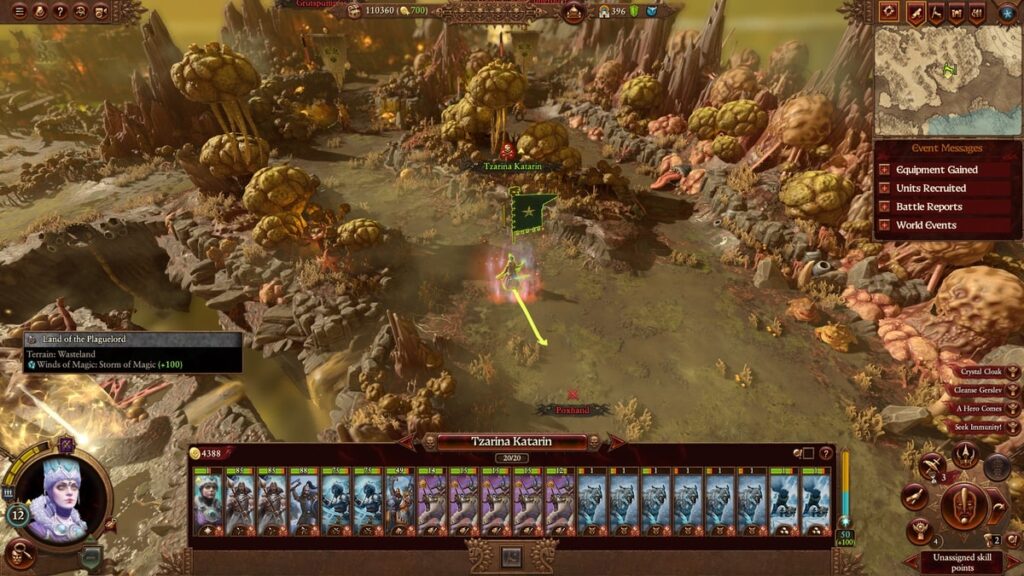
The climactic battles in each of these realms is one of the innovations in Total War Warhammer 3, Creative Assembly crafting a new style of battle. Survival battles have a new multi-stage, tasking you with capturing a core control point and then holding it from waves of Chaos defenders. It even allows you to summon new and more powerful reinforcements to your side through portals, ramping up through three stages until you face off against a champion of Chaos.
Its influence can also be felt in the battles through the rest of the game, as big walled city sieges and minor settlement battles now have half a dozen control points to capture which give control over an area and its defensive towers and barricades. The maps themselves are better themed after the location and race, and feel more inventive, such as having NORSCA settlements build in a giant Chaos symbol, or having towns built up around a hill with a sheer drop, giving you a few different
There’s an impressive array of races and factions included in Total War Warhammer 3. The four Chaos Gods – Khorne, Nurgle, Slaanesh and Tzeentch – each have their own faction, but then there’s also the Daemon Prince that can draw from all four powers for an empire of Chaos Undivided. Arrayed against them are the Russia-inspired Kislev and the Imperial China-inspired Grand Cathay, while the day one DLC race of the Ogre Kingdoms is being bundled in for those who pre-order.

Each one has a different tone that ties into different styles of play. Kislev’s units specialise in being hybrid ranged and melee, making them excel in defensive battles as they weaken onrushing enemies and then pull out axes and spears to go toe to toe with them. Meanwhile, Grand Cathay’s armies are all about harmony, emphasising synergy and balance between your army’s formation, which will buff your units if you get it right. Khorne players will want to dive headlong into melee combat, while Tzeentch relies more on magic, and so on. Of course, the Daemon Prince gets to pick and choose from all four of the Chaos Gods, making him much more flexible.
The Daemon Prince also has his unique body-swapping character customisation suite. All of the heroes and lords can earn skills and level up, while being outfitted with weapons and armour, but the Daemon Prince can literally swap out body parts, from his head down to his toes and the tip of his tail, picking and choosing from favours granted to him by the Chaos Gods seeking his allegiance. Everything you do in the campaign can be dedicated to a particular god or Chaos Undivided, aligning particular settlements with a god to unlock their units, and putting daemonic Glory toward earning new body parts. At a base level, you’re going to want to simply pick what’s most powerful and pick a path, but there’s real flexibility in mixing and matching different gods to make your Khorne leaning Prince leave behind pestilent trails of Nurgle slime in battle, for example.

That’s one of the more inventive campaign twists found in Total War Warhammer 3, but not far behind is Grand Cathay’s litany of gameplay ideas based on Imperial China. It’s to the point of caricature, as you defend the Great Wall of China Great Bastion from roving Mongol Tzeentchian hordes, send out trade convoys along the Silk Road Ivory Road with little narrative events, and have a constant obsession with keeping Yin and Yang in balance. Every hero, building and technology you research tips this balance one way or the other, and the significant buffs that perfect balance gives to your empire will have you constantly micro-managing.
the bitter and embattled Kislev or the individual Chaos gods have their own twists on the standard Total War campaign – Nurgle can concoct new plagues and has unusual cyclical buildings, Tzeentch can teleport armies and more directly control the Winds of Magic, while Khorne’s all about constantly throwing armies into battle, which can spawn new armies to throw into even more battles. Everyone also gets all the quality of life improvements for customising what the end turn rigmarole shows you, new diplomacy options to build an outpost in an ally’s city so that you can then recruit from their unit types, and more. It’s a nice refinement from Total War Warhammer 2, and builds on the work done on historical Total War games over the last few years.
- About
- All
- AREA
- Army
- around
- barriers
- Battle
- Bay
- body
- build
- Building
- Campaign
- China
- City
- cooking
- Creative
- day
- different
- down
- dozen
- Drop
- Earning
- eastern
- events
- Excel
- Face
- FANTASY
- First
- Flexibility
- Focus
- game
- gameplay
- Games
- Giving
- great
- Harmony
- having
- head
- Home
- How
- HTTPS
- Hybrid
- Included
- influence
- IT
- keeping
- large
- LEARN
- Level
- location
- Making
- map
- Maps
- more
- North
- Options
- Other
- play
- players
- Portal
- power
- powerful
- Preview
- Prince
- quality
- Race
- RE
- real-time
- research
- REST
- Revealed
- review
- rivals
- road
- s
- settlement
- significant
- skills
- So
- Soul
- Story
- Strategy
- style
- talking
- Technology
- The
- the world
- Through
- time
- tips
- top
- trade
- transport
- unique
- unlock
- unusual
- war
- waves
- What
- WHO
- Work
- world
- years
- youtube

